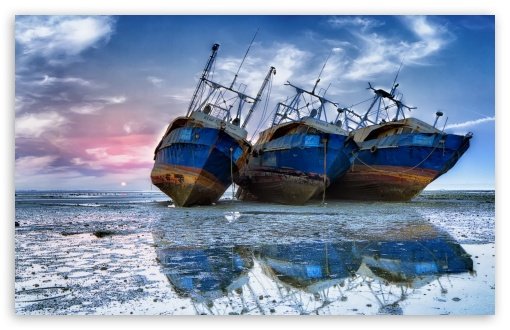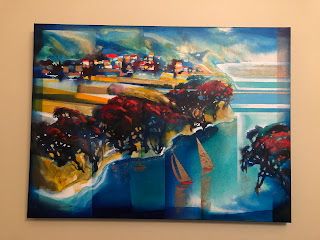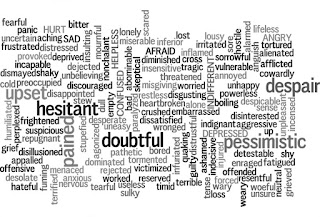There has been some speculation as to the background to THE BLUE MAN's colours.
Yes, it is true that the predominant (actually the only) colours in my make-up are blue and orange.
A rugby enthusiast opined that it may have something to do with the colours of the Otago Rugby Union and its Super Rugby team THE HIGHLANDERS. Well this guy is in the realms of fantasy there as I hate Super Rugby and if I did support a team it wouldn't be one that represented drunken and irresponsible Dunedin university students.
 |
| No connection here |
Another idiot contributor hinted at a Donald Trump connection with the splashes of orange. It's amazing what social media brings out nowadays with certifiable nutters being given free rein to their opinions (just look at the blogs of some of the commentators to this blog).
 |
| You'd have to be joking |
Colours do have significance and, through history.
************************
BLUE
Blue is the colour of the sky and sea. It is often associated with depth and stability. It symbolises trust, loyalty, wisdom, confidence, intelligence, faith, truth, and heaven.
Blue is considered beneficial to the mind and body. It slows human metabolism and produces a calming effect. Blue is strongly associated with tranquility and calmness. In heraldry, blue is used to symbolise piety and sincerity.
You can use blue to promote products and services related to cleanliness (water purification filters, cleaning liquids, vodka), air and sky (airlines, airports, air conditioners), water and sea (sea voyages, mineral water).
Blue is a masculine colour; according to studies, it is highly accepted among males. Dark blue is associated with depth, expertise, and stability.
Blue is seldom used to promote food and drink though as blue bottles and containers were used in olden times to store poisons. Avoid using blue when promoting food and cooking, because blue suppresses appetite. Mike should have taken this into consideration when he bought a Chinese wine in a blue bottle and gave it to THE WINE GUY. He nearly poisoned the poor guy as the wine had di-ethylene-glycol in it.
The history of blue as a colour for everyday man began when the Catholic Church made an important move in the year 431 AD. At this time, the Church decided to colour-code the saints, and Mary was given a blue robe. Over time, the shade of blue that Mary wore became what is now known as "navy blue." Because Mary stood for innocence and trustworthiness, the colour blue was seen as a positive light. This same navy blue was adopted by militaries and police to convey a similar essence of trust.
As navy blue became more popular among authorities, people began to associate it with the idea of authority. Thus, different shades of blue needed to be developed in order to convey the colour's original peaceful, subdued meaning. Robin's egg blue and pale, powder blue were developed for this purpose.
The history of blue as "the colour for boys" is an even newer notion that primarily arose after the post World War II baby boom. It came about as a marketing scheme, as manufacturers could sell more clothes if some were distinctly for boys, and others were distinctly for girls.
The history of blue is fascinating and I will write a longer post on this sometime in the future. In short blue has been associated with music (The Blues), song titles, making errors, names for Australian blokes, bad language and feelings: We all have felt sad sometimes or, in other words, we've all been 'blue'.
I mentioned 'navy-blue' earlier. The Navy has a link to 'feeling blue'. It refers to a custom that many old deepwater sailing ships follow. Which is - If the ship lost the captain or any of the officers during its voyage, she would fly blue flags and have a blue band painted along her entire hull when returning to home port.

***************************
ORANGE
Orange combines the energy of red and the happiness of yellow. It is associated with joy, sunshine, and the tropics. Orange represents enthusiasm, fascination, happiness, creativity, determination, attraction, success, encouragement, and stimulation.
To the human eye, orange is a very hot colour, so it gives the sensation of heat. Nevertheless, orange is not as aggressive as red. Orange increases oxygen supply to the brain, produces an invigorating effect, and stimulates mental activity. It is highly accepted among young people. As a citrus colour, orange is associated with healthy food and stimulates appetite. Orange is the colour of Autumn and harvest. In heraldry, orange is symbolic of strength and endurance.
Orange has very high visibility, so you can use it to catch attention and highlight the most important elements of your design. Orange is very effective for promoting food products and toys. Much hi-vis clothing and machinery is coloured orange. Its high visibility makes it a popular colour for lifeboats and safety equipment like lifejackets and floatation devices. It is also widely worn by cyclists and road workers to avoid being hit.
Dark orange can mean deceit and distrust.
Red-orange corresponds to desire, sexual passion, pleasure, domination, aggression, and thirst for action.
Throughout history orange, for many cultures was seen as a sacred colour but, unlike many other colours orange is polarising - you either hate it or love it.
Orange is bold and striking. For some, it makes a statement; others think it garish. From ancient Egyptian art through12th century icons to modern art, paintings with orange pigment have permeated world culture for thousands of years.
 |
| (Pomona by Nicolas Fouché c.1700), the goddess of fruitful abundance, was often depicted in orange; her name derived from the Latin word pomon, meaning fruit. |
Ancient Egyptian artists used an orange mineral pigment called realgar for tomb paintings. The same pigment was later used for colouring manuscripts by medieval artists. Orange pigments were also made in ancient times from a mineral known as orpiment, whose naturally golden-yellow hue made it of great interest to alchemists; they conjectured it held the secret to forming gold. Orpiment was traded in the Roman Empire and was used as medicine in China despite its high arsenic content. No doubt Mike will give THE WINE GUY a Chinese wine in an orange bottle sometime soon.
For centuries, orpiment was ground down and used as pigment in painting and sealing wax. In fact, it was one of the few clear, bright pigments available to artists until the 19th century, whose dawn saw the introduction of cadmium yellows, chromium yellows and organic dye-based colours. After the 19th century, orpiment became redundant because of its extreme toxicity and incompatibility with other common pigments, such as verdigris and azurite.
In 1797, French scientist Louis Vauquelin discovered the mineral crocoite, which led in 1809 to the advent of the synthetic pigment chrome orange. Other synthetic pigments, cobalt red, cobalt yellow and cobalt orange, made from cadmium sulphide plus cadmium selenite, soon followed. These new pigments, plus the invention of the metal paint tube in 1841, meant artists could paint outdoors and capture the colours of natural light.
In England orange became very popular with the Pre-Raphaelites, a group of English painters, poets and critics, founded in 1848. The flowing red-orange hair of Elizabeth Siddal, the wife of painter Dante Gabriel Rossetti, became a symbol of the Pre-Raphaelite movement. Albert Joseph Moore painted festive scenes of Romans wearing bright orange cloaks brighter than any Roman would have worn.
French artists took orange in a different direction. In 1872, Claude Monet painted Impression Sunrise in which a tiny orange sun is the focal point of the image—its reflection illuminating the water’s surface. The painting gave its name to the impressionist movement.
Orange became an important colour for all the impressionist painters. Having studied recent books on colour theory, they knew orange placed next to azure blue made both colours appear much brighter. Auguste Renoir painted boats with stripes of chrome orange straight from the paint tube.
The post-impressionists went further with orange. Paul Gauguin used orange as backgrounds, for clothing and skin colour, to fill his paintings with light and exoticism.
But Vincent Van Gogh was perhaps the most prolific user of the colour. Orange and yellow represented for Van Gogh the pure sunlight of Provence.

Orange has political connections being the colour of Christian democratic political ideology. It is associated with Protestantism in Northern Ireland, linked to the Orange Order, a Protestant fraternal organisation.
In Holland orange is a very popular colour even though it isn't represented in the nation's flag. It's roots can be traced back to the beginnings of the Netherlands: Orange is the official colour of the Dutch royal family and began with Willem van Oranje (William of Orange) who was the leader of the Dutch revolt against the Spanish Habsburgs, a movement which led to Dutch independence in 1581.
With thanks to the internet via Google for much of this information and Wikipedia and Art & Collections.
***********************
As you can see none of the above - history, art*, politics or religion has anything to do with the origins of THE BLUE MAN'S colours and I frankly wonder why I bothered
writing researching copying and pasting it.
I hope that it was of interest though. Please let me know as, in my trawling I discovered much, much more that I can borrow for you.
*THE BLUE MAN image I use is from an oil painting we own and which is in the study above the computer. It was painted by Christchurch artist Stehanie McEwin.






















